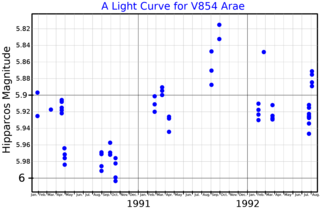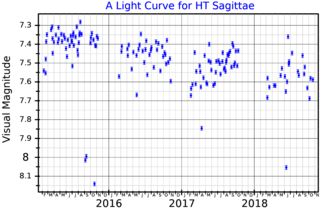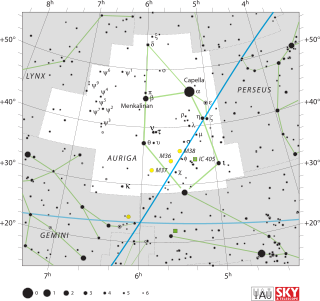
Albireo is a binary star designated Beta Cygni. The International Astronomical Union uses the name "Albireo" specifically for the brightest star in the system. Although designated 'beta', it is fainter than Gamma Cygni, Delta Cygni, and Epsilon Cygni and is the fifth-brightest point of light in the constellation of Cygnus. Appearing to the naked eye to be a single star of magnitude 3, viewing through even a low-magnification telescope resolves it into its two components. The brighter yellow star, itself a very close trinary system, makes a striking colour contrast with its fainter blue companion.

Sigma Aquilae, Latinized from σ Aquilae, is the Bayer designation for a binary star system in the equatorial constellation of Aquila. The baseline apparent magnitude of the pair is +5.17, which, according to the Bortle Dark-Sky Scale, is bright enough to be seen with the naked eye from suburban skies. Because of the Earth's orbit about the Sun, this system has an annual parallax shift of 4.18 mas. This provides a distance estimate of approximately 780 light-years.

Chi Aquilae is the Bayer designation for a binary star in the equatorial constellation of Aquila, the eagle. This system is bright enough to be seen with the naked eye at a combined visual magnitude of +5.29. Based upon parallax measurements made during the Hipparcos mission, Chi Aquilae is at a distance of approximately 900 light-years from Earth.

18 Aquilae is a triple star system in the constellation of Aquila. 18 Aquilae is the Flamsteed designation; it also bears the variable star designation Y Aquilae. It has an apparent visual magnitude of 5.07, making it bright enough to be seen with the naked eye. The distance to this system can be estimated from the annual parallax shift of 6.43 mas, yielding a value of around 510 light-years away from Earth.
51 Aquilae is a star in the equatorial constellation of Aquila. 51 Aquilae is its Flamsteed designation. It has an apparent visual magnitude of 5.39, which means it is faintly visible to the naked eye. Based upon an annual parallax shift of 35.88 mas, the distance to this star is around 90.9 light-years.

28 Aquilae, abbreviated 28 Aql, is a star in the equatorial constellation of Aquila. 28 Aquilae is its Flamsteed designation though it also bears the Bayer designation A Aquilae, and the variable star designation V1208 Aquilae. It has an apparent visual magnitude is 5.5, making this a faint star that requires dark suburban skies to view. The annual parallax shift of 9.6 mas means this star is located at a distance of approximately 340 light-years from Earth.

35 Aquilae is a star in the equatorial constellation of Aquila. 35 Aquilae is its Flamsteed designation though it also bears the Bayer designation c Aquilae. The apparent visual magnitude of this star is 5.8, which means it is a faint star but visible to the naked eye from dark suburban or rural skies. It has an annual parallax shift of 16.34 mas that is caused by the Earth's orbit around the Sun. This yields a distance estimate of 200 light-years, give or take a 4 light-year margin of error. At this distance, the visual magnitude is diminished by 0.26 from extinction caused by interstellar gas and dust.

10 Aquilae is a star in the equatorial constellation of Aquila. 10 Aquilae is the Flamsteed designation. It has an apparent visual magnitude of 5.9 and thus is a faint star that is just visible to the naked eye in dark skies. The brightness of this star is diminished by 0.17 in visual magnitude from extinction caused by interstellar gas and dust. Based on an annual parallax shift of 13.45 mas, the distance to this star is around 240 light-years.

4 Cassiopeiae is a red giant in the northern constellation of Cassiopeia, located approximately 790 light-years away from the Sun. It is visible to the naked eye as a faint, red-hued star with a baseline apparent visual magnitude of 4.96. At the distance of this system, its visual magnitude is diminished by an extinction of 0.56 due to interstellar dust. This system is moving closer to the Earth with a heliocentric radial velocity of −39 km/s.

V Aquilae is a carbon star and semiregular variable star in the constellation Aquila. It has an apparent magnitude which varies between 6.6 and 8.4 and is located around 400 parsecs (1,300 ly) away.

FF Aquilae is a classical Cepheid variable star located in the constellation Aquila, close to the border with Hercules. It ranges from apparent magnitude 5.18 to 5.51 over a period of 4.47 days, meaning it is faintly visible to the unaided eye in rural or suburban settings.

V923 Aquilae is a variable binary star system in the equatorial constellation of Aquila. It has the designation HD 183656 from the Henry Draper Catalogue; V932 Aql is the variable star designation. The system is dimly visible to the naked eye with an apparent visual magnitude that fluctuates around 6.06. It is located at a distance of approximately 890 light years from the Sun based on parallax, but is drifting closer with a radial velocity of around −26 km/s.

HD 155035 is a star in the constellation Ara, the Altar. It is located at a distance of approximately 1,450 light-years from Earth and has an apparent visual magnitude of 5.92, making it is faintly visible to the naked eye. This is a red giant star with a stellar classification of M1.5 III.

Beta Monocerotis is a triple star system in the constellation of Monoceros. To the naked eye, it appears as a single star with an apparent visual magnitude of approximately 3.74, making it the brightest visible star in the constellation. A telescope shows a curved line of three pale blue stars. William Herschel who discovered it in 1781 commented that it is "one of the most beautiful sights in the heavens". The star system consists of three Be stars, β Monocerotis A, β Monocerotis B, and β Monocerotis C. There is also an additional visual companion star that is probably not physically close to the other three stars.

Chi2 Orionis is a B-type blue supergiant star in the constellation of Orion. It has an apparent visual magnitude of 4.63 but being quite distant, and heavily extinguished it burns with the greatest absolute visual light magnitude among stars in Orion within the near reaches of the galaxy, 0.9 of a magnitude brighter than Rigel. Since 1943, the spectrum of this star has served as one of the stable anchor points by which other stars are classified. It is considered to be a member of the Gemini OB1 association.

1 Camelopardalis is a double star system in the constellation Camelopardalis. Its combined apparent magnitude is 5.56 and it is approximately 800 parsecs (2,600 ly) away. It is faintly visible to the naked eye under good observing conditions.

9 Cephei, also known as V337 Cephei, is a variable star in the constellation Cepheus.

HD 183143 is a blue hypergiant star located in the constellation of Sagitta.

WZ Columbae, also known as HD 38170, is a solitary, bluish-white hued star located in the southern constellation Columba, the dove. It has an apparent magnitude of 5.28, allowing it to be faintly visible to the naked eye. Based on parallax measurements from the Gaia spacecraft, the object is about 365 light years distant. It appears to be receding from the Solar System, having a heliocentric radial velocity of 36.3 km/s.

HD 51418 is an Ap star and an α2 CVn variable located about 178 parsecs (580 ly) away in the northern constellation of Auriga. With an apparent magnitude of 6.67 and a spectral type of A0, it can be faintly visible by the naked eye as a whitish dot under very good circumstances. The star has been noted as an "extreme lanthanide star," with an overabundance of metals including europium, dysprosium, and holmium, which can be observed in the star's spectra as emission lines.














